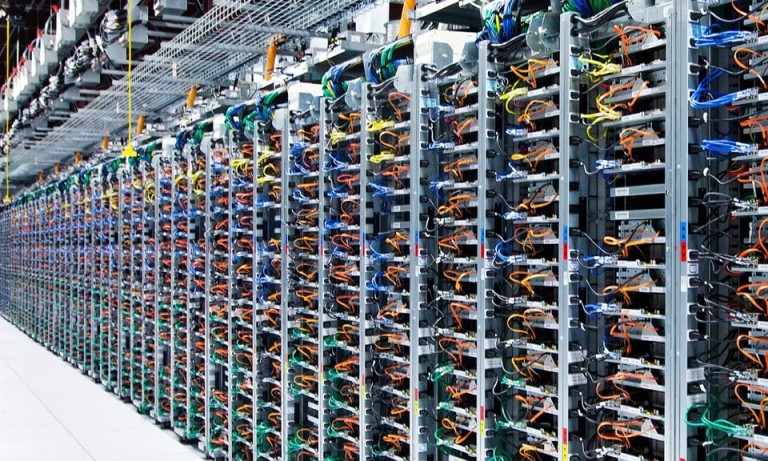
Fabric Virtualization Made Simple
Allied Telesis optimizes the private data center
Data storage innovation has led to significant developments in the implementation of data networks.
For many years, an organization’s data storage consisted of a ‘server farm’, which workstations accessed via a multi-tier data network. Redundancy was provided by Spanning Tree Protocol (STP), and by Virtual Router Redundancy Protocol (VRRP) at the Layer 3 boundary between the access and server sides of the network.
This was a reliable solution for a static environment, on a scale typical of enterprise data storage needs. However, data centers have now grown into large scale, highly dynamic environments, in which extremely reliable, high-speed data access is essential. New data connectivity solutions are required to support these requirements.
Virtualized forwarding fabric—a more effective model
Treating the network as a virtualized forwarding fabric has become an effective model for data center connectivity. The key advantages that this model provides are:
- Flexibility in where end-point devices can connect to the network.
- Seamless migration of virtual computing nodes.
- Higher bandwidth paths between any two end-point devices.
- Automatic recovery from the loss of any link inside the network.
- Simple integration of new forwarding nodes into the network.
The virtualized fabric model is highly scalable. It applies equally as well to a large, multi-tenant data center as it does to a single organization’s in-house data center.
In very large-scale installations, the network fabric is implemented by path-optimizing protocols—either Transparent Interconnection of Lots of Links (TRILL) or Shortest Path Bridging (SPB).
In smaller-scale environments, a fully reliable network mesh can be achieved simply by combining switch clustering with link aggregation.
Allied Telesis network fabric solutions
Allied Telesis has developed highly optimized and feature-rich network fabric solutions based on the simple combination of switch clustering and link aggregation.
Allied Telesis has two types of network fabric solutions:
- A collapsed leaf and spine topology based on a clustered pair of core chassis switches.
- A full leaf and spine topology, using clustered switches for the leaves and the spine.
Collapsed leaf and spine topology
Switchblade SBx8100 Layer 3 chassis switches can be aggregated together to operate as a single virtual Layer 3 switch, using Allied Telesis VCStack Plus™. VCStack Plus creates a completely unified Layer 3 switching fabric, across two physical chassis, with a combined forwarding capacity of 3.8 Terabits.
Within this topology, the leaf nodes are the Line Interface Cards (LIFs) that contain the chassis’ network ports. The Spine nodes are the Central Fabric Controller (CFC) cards that forward data between the LIFs.
A complete solution
The virtual network fabric that can be created using VCStack Plus provides a considerably more complete solution than the Layer 2 Multichassis Link Aggregation Group (M-LAG) offerings that exist elsewhere in the market.
VCStack Plus creates a fully-featured Layer 3 network extended across the aggregated forwarding plane. The switching of IPv4 and IPv6, unicast and multicast, at Layer 2 and Layer 3 is seamlessly shared across the combined fabric, with fully synchronized forwarding tables.
The forwarding plane is resilient to the loss of one or more spine nodes (CFC cards). If a card fails or is removed, there is a consequent reduction in the available bandwidth, but no loss of end-to-end flows through the fabric. Traffic is instantly redistributed across the remaining intra-fabric links, without any requirement for Layer 3 protocol reconvergence, or route table recalculations.
In an M-LAG solution, the constituent chassis have no sharing of Layer 3 forwarding information. If one chassis leaves the cluster, the remaining chassis need to then learn the Layer 3 forwarding information from the network, and populate their Layer 3 forwarding tables. This adds delay to the recovery time from the loss of the chassis. For Layer 3 multicast forwarding, in particular, this delay can be considerable.
A key advantage of VCStack Plus over an M-LAG system is that with VCStack Plus, all the forwarding tables of all the ASICs are kept constantly synchronized. If any constituent of the system is lost, there is no delay caused by some previously empty forwarding tables being populated, because all the tables are already populated.
The resulting network fabric has the capability, resiliency, low latency, and low-touch unit integration of more complex fabric solutions based on protocols like TRILL or SPB, and it also has the added advantage of simplicity.
The traffic sharing across fabric links is achieved by the simple process of link aggregation, not by a more elaborate process of MAC path distribution, and extra packet encapsulation. Therefore the operation of the fabric network is more transparent to network managers, and embodies the inherent reliability of a mature, well-established technology.
Optimized management experience
In addition, VCStack Plus provides an optimized management experience:
- The combined chassis are managed as a single unit.
- Routing information is automatically shared between the chassis—no routing protocols are required to enable this information to be shared.
- A single, combined, configuration file is distributed across both chassis.
- Statistics and logging information are obtained in a combined manner from both chassis.
- Controller cards or line cards can be hot-swap replaced in either chassis, and will be automatically integrated into the system, with appropriate software image and configuration applied to them, without need for user intervention.
- Hitless software upgrades can be performed on the chassis pair, as the In-Service Software Upgrade (ISSU) mechanism manages the sequential upgrade of multiple CFCs whilst maintaining continuous availability of the system as a whole.
Full leaf and spine topology
The Allied Telesis leaf and spine network can be scaled up by dedicating a VCStack Plus pair of x8100 chassis, or alternately a VCStack pair of switches such as SwitchBlade x908 GEN2, as the spine, and attaching stacked switches as the leaf nodes.
In this case, x950, x550 and x530 Series switches are shown as leaf nodes. This flexibility, and the capability to uplink to the spine at speeds right up to 100Gbps enable a solution that is not only resilient, but extremely high performing.
Once again, the fabric link resiliency is provided by aggregation of the links from the leaves to the spine. As the spine and leaf units are all implemented as VCStacks, they each appear to the rest of the network as single units. The leaf nodes act internally as active-active resilient pairs of units, but no external protocol interaction with other network nodes is required to support this active-active resiliency.
Hence, path resiliency between nodes can be provided by simple link aggregation. By terminating the different links within a Link Aggregation Group (LAG) on different members of the stack at each end of the LAG, the connection is resilient to failure of a link and to failure of an end-point switch.
Unlike the case of the collapsed leaf and spine, this full leaf and spine topology does require that routing information is exchanged between leaf nodes and the spine. However, the full synchronization of all Layer 2 and Layer 3 forwarding tables within each node provides a powerful benefit—no table resynchronization is required upon the failure of a unit within a stack.
Unified management
A true network fabric not only operates as a unified forwarding plane, but can also be managed as a unified entity.
Allied Telesis Autonomous Management Framework™ (AMF) enables unified management of a multi-node network of Allied Telesis switches, and automated integration of new units into the network.
AMF embeds network management intelligence into the switches so that:
- The switches operate with a unified Command Line Interface (CLI). Commands that are entered into the unified CLI are issued to all member switches simultaneously.
- When a new node is connected to the network, it is automatically connected to the unified management plane, and provided with its full configuration without user intervention. So, the fabric network can be seamlessly expanded by simple physical attachment of new nodes.
- All essential files on the member nodes are automatically backed up on a regular basis.
- If a node fails, then it can be replaced in a zero-touch manner. The replacement node is simply connected to the network, and the network automatically restores to it the exact configuration that existed on the failed node.
For full visibility, Allied Telesis Vista Manager EX graphical monitoring and administration tool integrates the network automation provided by AMF in an easy to use and powerful management solution.
The result: powerful simplicity
The combination of VCStack and/or VCStack Plus with AMF delivers simple, reliable, convenient virtualized fabric solutions for the private data center.
By utilizing true chassis stacking as a collapsed leaf and spine, in which a pair of SBx8100 chassis switches operates as a fully integrated unit, Allied Telesis has implemented a multi-layer, multiprotocol virtualized fabric that utilizes simple mechanisms for connection resiliency. A full leaf and spine topology offers even more speed and connectivity flexibility for distributed environments.
On top of this, AMF provides automated integration of new nodes into the fabric, and the ability to manage the network as a single entity—along with complete visual monitoring and management using Vista Manager EX.
The net result is an uncomplicated, scalable fabric for the private data center.




